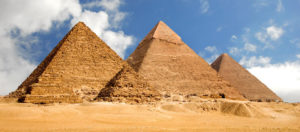
Enslaved workers reportedly used a system of waterways to transport the two-ton bricks of stone to the pyramid. (Image courtesy of Wikipedia Commons)
The mystery surrounding who built Egypt’s Great Pyramid at Giza (and exactly how they pulled it off) may have just been solved, finally putting several competing theories to rest.
Archaeologists recently uncovered what they believe to be the diary of an overseer that suggests Ancient Egyptians harnessed the power of the Nile River to transport the almost two-ton blocks of stone to the towering edifice over 4,500 years ago, Newsweek reported.
Before this, experts believed the giant stones from the pyramid’s chamber came all the way from Luxor (about 500 miles south of Giza) but never agreed on how they wound up there. A new British documentary titled “Egypt’s Great Pyramid: The New Evidence” now suggests that the structure was engineered using a sophisticated system of waterways that allowed thousands of enslaved workers to pull the huge stones, using boats, into place with ropes.
The discovered text, written by an overseer named Merer, explained how his group of workers dug huge canals to guide the water of the Nile to the Great Pyramid.
Archaeologist Mark Lehner and his team also uncovered a hidden waterway beneath the Giza plateau, according to Newsweek. Experts posit that the stones that ultimately went into the pyramid were delivered near this area.
The magazine reported that separate group of archaeologists with the ScanPyramids project is now working to create an internal map of the Great Pyramid using laser technology. So far, the team has found several voids in the pyramid that they think could be hidden rooms.


